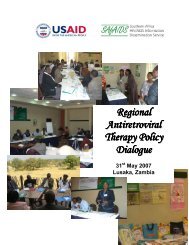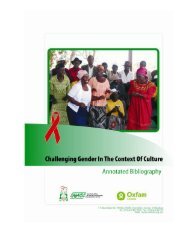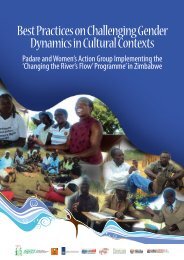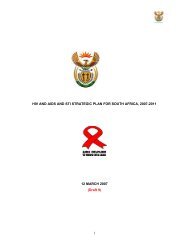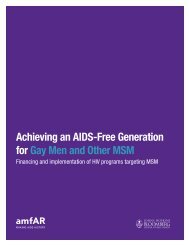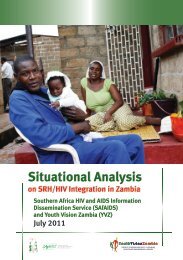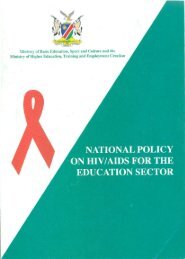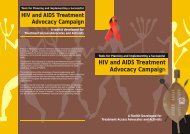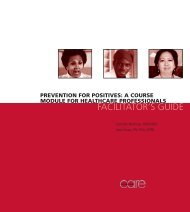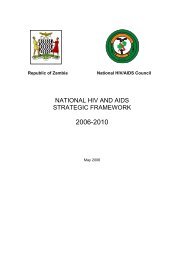What was also observed was that training priorities <strong>and</strong> curricula for nurses <strong>and</strong> someundergraduate medical pr<strong>of</strong>essional courses are not consistent with needs, <strong>and</strong> requireupdating to ensure their relevance to local conditions <strong>and</strong> dem<strong>and</strong>s. Also, the fact that inservicetraining is not properly integrated <strong>and</strong> co-ordinated leads to significant numbers <strong>of</strong>front line staff spending more time attending in-service programmes than providing theservice.8.2 Conditions <strong>of</strong> work for health staffSwazil<strong>and</strong> <strong>and</strong> Zambia’s investment in the Health sector has not been commensurate with theincreasing dem<strong>and</strong> for health services due to <strong>HIV</strong> <strong>and</strong> AIDS <strong>and</strong> other re-emerging epidemicslike TB. In Swazil<strong>and</strong> the exodus <strong>of</strong> skilled health workers from the public sector is mainlyattributed to lack <strong>of</strong> career progression, unattractive terms <strong>and</strong> conditions <strong>of</strong> service, poorworking environment <strong>and</strong> lack <strong>of</strong> incentives. The remaining staff are succumbing to attritionemanating from increased disease burden mainly <strong>HIV</strong> <strong>and</strong> having to work with inadequatematerials <strong>and</strong> medicines. They are further not protected from occupational exposure to <strong>HIV</strong>. InZambia, the conditions <strong>of</strong> work in the health sector are not considered attractive enough tokeep staff in their positions. Factors contributing to limited health staff <strong>and</strong> mal-distribution <strong>of</strong>health workers in Zambia include the following:• Highly qualified staff feel intellectually <strong>and</strong> socially isolated in rural communities <strong>and</strong>hence are reluctant to work in rural areas;• Poor st<strong>and</strong>ards <strong>of</strong> accommodation;• Amenities, such as electricity <strong>and</strong> phones, that staff have been accustomed to elsewhere, are absent in rural areas;• Transport <strong>and</strong> communication to maintain contact with family <strong>and</strong> colleagues is limited;• Pr<strong>of</strong>essional support <strong>and</strong> staff development is lacking in rural areas;• Educational facilities for children are below st<strong>and</strong>ard; <strong>and</strong>• The range <strong>of</strong> pr<strong>of</strong>essional skills required may not be matched by prior training.According to the World Bank 8 , Governments <strong>of</strong> the region have set up the Africa HealthWorkforce team to build an evidence base to determine what type <strong>of</strong> incentives motivatehealth workers to stay in their country. Among other things, the World Bank recognises thatGovernments need to provide improved equipment, safe housing <strong>and</strong> access to training, apartfrom improved remuneration.44
9.0 EXTERNAL OVERSIGHT MECHANISMSThere is increasing consensus that external <strong>and</strong> independent audit <strong>and</strong> oversight <strong>of</strong> theexecutive is essential to improving government performance in service delivery <strong>and</strong> otherareas. The AU Convention on Preventing <strong>and</strong> Combating Corruption, among other things,requires States to “establish, maintain <strong>and</strong> strengthen independent national anti-corruptionauthorities or agencies”. In pursuance <strong>of</strong> these normative st<strong>and</strong>ards, we examine in the twocountries the existence <strong>and</strong> efficacy <strong>of</strong> action against corruption <strong>and</strong> misconduct, protection<strong>of</strong> whistle-blowers, the Supreme Audit Institution, existence <strong>of</strong> any anti-corruption agencies,independent investigation <strong>of</strong> public complaints <strong>and</strong> monitoring <strong>of</strong> performance by media<strong>and</strong> civil society. The section also examines if there is any linkage between <strong>HIV</strong> <strong>and</strong> AIDS coordinatingbodies <strong>and</strong> health ministries’ activities on <strong>HIV</strong> <strong>and</strong> AIDS <strong>and</strong> the national assemblies.9.1 National assemblySwazil<strong>and</strong>’s National Assembly is generally regarded as inaccessible or not independent onany issue, including <strong>HIV</strong> <strong>and</strong> AIDS. Swazil<strong>and</strong> is an absolute traditional monarch, headed by aking (King Mswati III since 25 April 1986). Government is headed by a prime minister appointedby the king. The most recent general election in October 2008 was the first under a newconstitution agreed in 2006. International election observers were invited for the first time ever,although some pro-democracy protestors were arrested. Generally, when a public outcry ismade, it takes time for the central government to react <strong>and</strong> sometimes there is no action at all.Unlike in Swazil<strong>and</strong>, there exists a clear link between NAC, MoH <strong>and</strong> the National Assemblyin Zambia, through the Cabinet Committee <strong>of</strong> Ministers on <strong>HIV</strong> <strong>and</strong> AIDS. The Committeeis comprised <strong>of</strong>, Ministers <strong>of</strong> Health, Finance <strong>and</strong> National Planning, Sport, Youth <strong>and</strong> ChildDevelopment, Education, Labour <strong>and</strong> Social Security, Mines <strong>and</strong> Mineral Development,Communications <strong>and</strong> Transport <strong>and</strong> Information <strong>and</strong> Broadcasting Services. It provides policydirection <strong>and</strong>, supervises <strong>and</strong> monitors the implementation <strong>of</strong> <strong>HIV</strong> <strong>and</strong> AIDS programmes.In addition, the Public Accounts Committee in the National Assembly also has a legislativeoversight on all public expenditure accounts, which include money allocated for the <strong>HIV</strong> <strong>and</strong>AIDS national response.9.2 Action against corruption <strong>and</strong> misconductCurrently, Swazil<strong>and</strong> does not have an <strong>of</strong>fice <strong>of</strong> the ombudsman through which publiccomplaints can be investigated. The public can only have their complaints heard throughsection 35 <strong>of</strong> the Constitution which gives the High Court the jurisdiction to hear <strong>and</strong>determine claims against breach <strong>of</strong> any <strong>of</strong> the protective provisions <strong>of</strong> the constitution. UnlikeSwazil<strong>and</strong>, Zambia has two principal instruments providing the public with avenues for redresswhen concerned about service st<strong>and</strong>ards, corruption or misconduct by public servants.These are the institution <strong>of</strong> the Ombudsperson (Commission for Investigations) establishedunder section 90(1) <strong>of</strong> the Constitution <strong>and</strong> the Anti-Corruption Legislation (see Section 9.6).The ombudsperson is a public <strong>of</strong>fice, that is charged with representing the interests <strong>of</strong> thepublic by investigating complaints reported by citizens <strong>and</strong> addressing them, usually throughmediating a settlement. The <strong>of</strong>fice <strong>of</strong> the ombudsperson may initiate action on its own orrespond to issues referred by others. Absence <strong>of</strong> an ombudsperson <strong>of</strong>fice prejudices citizens bydepriving them <strong>of</strong> a formal complaint mechanism.45



